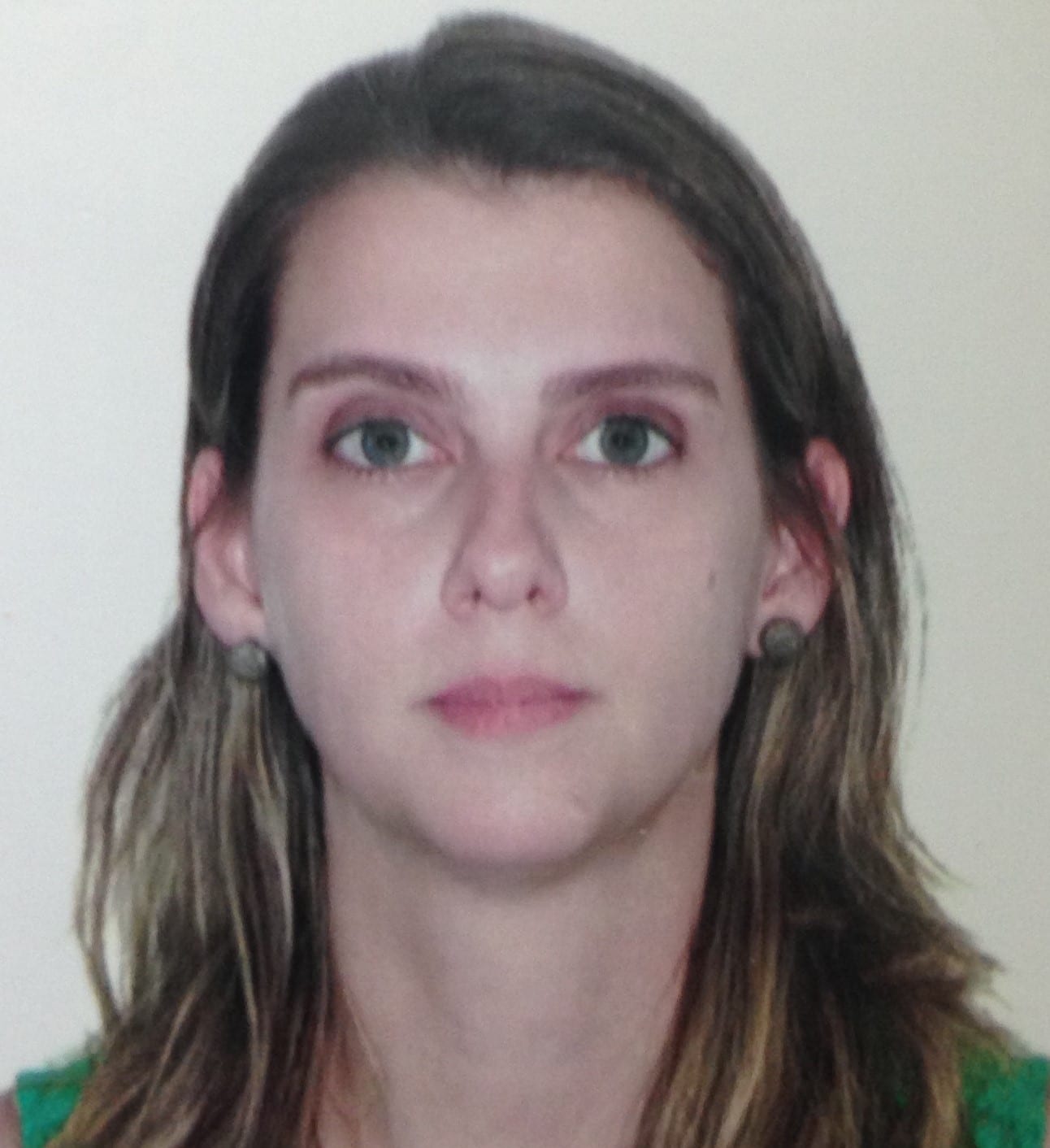ESCHER, Rafaela Bertoglio [2]
BRASILEIRO, Marislei Espíndula [3]
ESCHER, Rafaela Bertoglio; BRASILEIRO, Marislei Espíndula. Case Report: The Use of Activated Charcoal with Silver in the Treatment of Fasciotomy. Multidisciplinary Scientific Journal. Edition 9. Year 02, Vol. 01. pp. 47-56, December 2017. ISSN:2448-0959
abstract
Acute Compartment Syndrome is the increase of interstitial pressure on capillary perfusion pressure within an osteofascial compartment, which can compromise vessels, muscles and nerve endings causing tissue damage, and the emergency procedure called decompressive fasciotomy is indicated. Fasciotomies because they are very extensive and in potentially ischemic areas are more susceptible to infections and necrosis. Objective: to report the use of activated charcoal with silver in the topical treatment of fasciotomy in MIE. Method: Descriptive study, case report, performed at the inpatient clinic of the Vascular Surgery Unit of a tertiary hospital in the Federal District. Free and informed consent was obtained. Conclusion: silver-activated charcoal promoted a reduction in the infectious process, faster healing of the lesion, reduced the frequency of dressing change, providing comfort for the patient, until the lesion was restored and the wound was completely healed.
Key words: Case Report, Fasciotomy, Activated Charcoal with Silver.
INTRODUCTION
Currently, trauma has become one of the greatest challenges to the health care system of all countries in the world, with vascular trauma being an important component of this problem. According to the study by Costa-Val et al. (2008) of the 1000 cases of cardiovascular traumas treated at a trauma center, the majority were men (88%), young (mean age 26.9 years) due to injuries caused by various types of firearms (45.1%), , white arms / glasses (30.8%).
The treatment of the arterial lesions was done by means of primary suture, interposition and / or by-pass (venous and / or synthetic) in 91% of the cases, and 14% of these had to be reoperated mainly due to peripheral compartment syndrome by phenomenon ischemia / reperfusion (23%), critical ischemia due to acute arterial thrombosis (20%), and hemorrhage with hemodynamic repercussions (13%).
In this context, compartment syndrome is a condition in which high pressure within a body compartment reduces the capillary perfusion to below the level required for tissue viability. An increase in pressure within the compartment is not easily dissipated because of the inelasticity of the fascia surrounding the muscle. If the pressure remains high enough for several hours, normal muscle and nerve function becomes compromised and eventually triggers myelural necrosis, and permanent loss of function may occur (SERGIO, CAMERON, VITAL 2012).
Such impairment will lead to more ischemia and edema formation, and a vicious cycle will be established as the cells are deprived of oxygen. If adequate blood flow is not restored, the result is the death of the muscles inside the compartments, a condition that can only be resolved through fasciotomy (SERGIO, CAMERON, VITAL 2012).
Fasciotomy is defined as a decompressive surgical procedure, the purpose of which is to open the fascia that surrounds the muscle compartments in order to prevent neuromuscular ischemia and necrosis because it is very extensive and in potentially ischemic areas are more susceptible to infections and necrosis . The presence of infection ends up prolonging the inflammatory phase of the wound, hampering its healing. The infection causes further destruction of tissues and delays the repair process, thus increasing the formation of scar tissue, compromising function, esthetics or both.
In addition, there are the psychological factors associated with the procedure, since the surgical technique is invasive, with exposure of the tissues, and the prediction of prolonged healing by second intention, causes anguish and fear to the young client.
Thus, the daily evaluation of the nurse in the use of adequate coverage for this type of lesion is of great importance, several factors must be taken into account: depth, shape, size, amount of exudation, location, appearance, the environment for treatment and the classification of the wound. Other important factors that should be taken into account are patient comfort, ease of application, product efficacy and cost (GEOVANINI, 2014).
Silver activated carbon adsorbs the volatile gases through its activated carbon tissue, responsible for the bad smell and the microorganisms that produce this substance. The silver impregnated in activated charcoal fabric exerts bactericidal effect on the microorganisms aiding in the control of wound infection.
Due to the frequent attendance of these patients trauma victims and presenting compartment syndrome of the lower limbs came the interest for this Case Report.
GOAL
To report the use of silver activated charcoal in the topical treatment of a client with fasciotomy in the lower left limb.
METHOD
This is a descriptive study of the Case Report, using information obtained during the care provided to a patient attended at a Vascular Surgery Unit of a Hospital of Brasília, from February 17 to March 17, 2017.
From a scientific renewal point of view, the case report and case series are the means of choosing to discover something new, finding new ideas, enabling intellectual progress, showing new problems and solutions, and contributing to the medicine (KIENLE, 2011).
The individual case report arises from an assistance observation, are unplanned situations, where there is no previous project or objective. These reports document situations that present themselves to a prepared and attentive observer. In this perspective, there is no way to obtain a prior approval from the Research Ethics Committee. However, if more than three case reports are submitted together, this already sets up a number of cases. In this situation there is a need for approval by a Research Ethics Committee, because it is considered a publication resulting from a research project (GOLDIM & FLECK, 2010).
The individual study was authorized by the patient, through the signing of the informed consent form, respecting the principles of Resolution n. 466/2012. Thus, there was no experimental research, no new procedures or substances or interventions were used. The study is not replicable as it applies only to this patient. Nor is it a collection of cases, since one does not seek coherence between different or similar, but only the search for the description of the technique.
RESULTS AND DISCUSSION
Case presentation
Data collection and physical examination were performed on 02/20/17 by the care nurse.
Male, 19 years old, white, single, student, native of Goiás, resident of Águas Lindas do Goiás. Deny smoking, alcoholism and other drugs. Deny allergies and comorbidities. A firearm infusion victim was admitted to the emergency room of the Hospital on February 17, 2017 in the lower left limb. In the initial medical evaluation of the left leg motricity, there was no dorsiflexion and plantar foot flexion and fixed knee semiflexion. Featuring calf edema with increased volume and moist dressing. Being diagnosed with left popliteal artery injury, he was submitted to the emergency surgical procedure by the Vascular Surgery team of reconstruction of the left popliteal artery with contralateral saphenous vein and lateral decompressive fasciotomy. On the same day, he underwent a fasciotomy enlargement procedure.
On February 17, he was admitted to the immediate postoperative period at the Vascular Surgery Unit from the Anesthetic Recovery Room.
Physical examination: conscious, oriented in time and space, communicative, referring to apprehension in the evolution of his picture. Ventilating spontaneously in ambient air, pulse oximetry: 95% Hypocortical. Feverish Complaining of moderate pain in MIE. With central venous access in the right internal jugular vein. Hydrated. Oral diet with good acceptance. ACV: normophone sounds in 2-stroke, regular heart rhythm, normocardium. AP: symmetrical thorax, MV + in all extension, eupneic. ABD: abdomen flat, flaccid, painless to palpation, RHA +. Eliminations: urinary bladder catheter delay, clear diuresis in collection bag (800 ml). Not having intestinal elimination so far. Left lower limb (MIE) with externally cleaned dressing. Lower right limb with FO in clean inguinal region, dry, uncovered. With good peripheral perfusion, with edema of MMIIs, being maintained elevated.
Accompanied by the mother throughout the period.
Table 1 – Laboratory tests
| Exams | 02/20/17 | 03/03/17 | Reference values |
| Blood Cells | 2.70 | 4.56 | 4.00 – 5.00 |
| Hemoglobin | 8.1 | 13.0 | 12.00 – 15.00 |
| Hematocrit | 24.0 | 40.0 | 37.0 – 44.0 |
| Leukocytes | 13.4 | 7.7 | 4.0 – 11.0 |
| Total neutrophils | 78 | 71 | 45 – 75 |
| Rods | 3.0 | 1.0 | 0.0 – 0.4 |
| Segmented | 7.5 | 6 | 1.6 – 7.7 |
| Lymphocytes | 13 | 17 | 20 – 50 |
| Platelets | 113 | 193 | 150 – 450 |
| Creatinine | 0.82 | 0.92 | 0.70 – 1.20 |
| Potassium | 3.50 | 4,20 | 3.60 – 5.00 |
| Glucose | 148 | 89 | 80 – 120 |
| Sodium | 136 | 141 | 135 – 148 |
| Urea | 23 | 25 | 10 – 50 |
Source: Data provided and authorized by the patient.
On March 1st we received the result of the lesion fragment culture, with growth of Acinetobacter baumannii / haemolyticus (gram negative bacteria) and Staphylococcus aureus (gram positive bacteria).
According to the National Sanitary Surveillance Agency, surgical site infection (ISC) that is related to surgical procedures is one of the main infections associated with health care in Brazil, according to a national study carried out by the Ministry of Health describing a CSI rate of 11% of all surgical procedures (BISPO JUNIOR, A. et. al., 2013).
Fasciostomies fit according to the classification and criteria that define surgical infection, such as a deep incision that occurs within the first 30 days after surgery and presents at least one of the symptoms such as purulent drainage of the deep incision, abscess or other evidence that infection involves the deep planes of the wound, identified in reoperation, clinical examination, histocytologic examination or image examination (BISPO JUNIOR, A. et. al., 2013).
Table 2 – Medical prescription
| Free Diet VO |
| Physiological solution 0.9% 2500ml EV |
| Dipirone 2ml EV 6 / 6h |
| Metoclopramide 1 amp 8 / 8h EV SOS |
| Ertapenem 1g once daily |
| Tramal 1 amp 12 / 12h EV SOS |
Source: Data provided and authorized by the patient.
Infection of the lesion
The patient used systemic antibiotic therapy for 14 days. Given the options available in the sector for topical treatment of the lesion, we use activated charcoal associated with silver.
The antimicrobial power of silver has been related to its varied mechanisms of action. Silver interferes with bacterial metabolism, can break the wall of the bacterial cell and bind to its DNA, thereby inhibiting replication and the possibility of developing resistance. The mechanism is always the same, regardless of its presentation form. However, if it is in the elemental form, the silver must undergo an oxidation process in order to be transformed into a compound of silver oxide and silver ions, which confer the antimicrobial effect. One of the benefits of the elemental form is to be able to provide a larger reservoir of silver available on the roof, allowing a potential for release for an extended time (CANDIDO, 2006).
Silver-activated charcoal absorbs volatile gases through its activated charcoal fabric, responsible for the bad smell and micro-organisms that produce this substance. The rayon and polyamide layers are non-adherent, semipermeable, thermal insulation and absorbent. The non-adhesion confers properties to the dressing to avoid the loss of the newly formed tissue at the moment of removal or exchange of the same. The semipermeability of the tissue allows the exudate to flow to the secondary dressing in addition to providing a microenvironment with optimal moisture for wound healing.
Table 3 – Follow-up of the lesion
| Date | Edges and adjacent skin | Exudate | Bed | Size | Roof | Exchange |
| 2/18/02 to 2/21/2 | Integra; regular | serohematic | Viable fabric with shedding stitches | 30X15cm | Calcium Alginate | 24h |
| 22-28/02 | Integra; regular | seropurulent | Viable fabric with shedding stitches | 26X12cm | Activated carbon with silver | 24h |
| 03/01 to 03/03 | Integra; regular | serohematic | Granulation Fabric | 24X9cm | Activated carbon with silver | 72h |
Evaluation of the injury
In the first evaluation of the lesion on the external face of leg E, on February 18, 1st dressing, she had edema, herniation of the musculature, regular borders, adjacent skin integrates, serohematous exudate in large quantity, viable tissue largely with areas of sphagnum, opted as primary cover calcium alginate due to large amount of exudate, with daily exchange.
As of February 22nd, 5th dressing, we noticed the change in the characteristic of the exudate from serohemático to seropurulent, with signs of infection, patient presenting a fever of 38.5ºC since February 21. Feeling moderate pain in injury. Started the use of the cover with activated carbon with silver, with daily change. Initiated use of systemic antibiotic.
From the 1st of March, 12th dressing, due to the reduction and improvement of the appearance of the exudate, and the tissue of the lesion, we opted for the exchange on alternate days, every 72 hours.
On March 16, the patient was referred to the Surgical Center to close the lesion, since he already had 90% of granulation tissue, without signs of infection. The procedure was successful, with complete suture closure. Receiving hospital discharge on March 17.
Table 4 – Pictures of the lesion. Source: data provided and authorized by the patient.
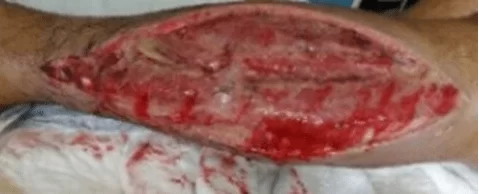
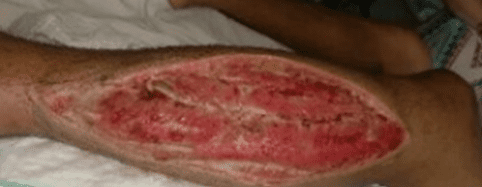
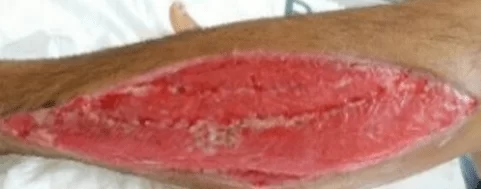
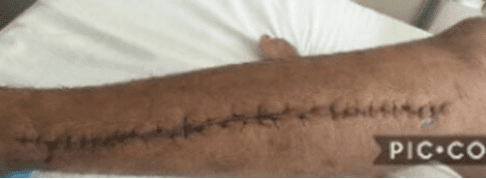
FINAL CONSIDERATIONS
In an evaluation performed 23 days after data collection, the patient presented satisfactory improvement with the positive aspect of the lesion, that is, with the closure of the lesion.
The treatment of compartmental extremity syndrome is surgical, and there is no prevention because there are no associated risk factors. The nursing team plays an important role in minimizing complications that may arise during hospitalization. Patient recovery and wound healing are the goals of care.
There are several factors that influence total tissue repair. Local factors, related to the wound can interfere in the cicatricial process, such as: size and depth of the lesion, degree of contamination, presence of secretions, hematoma and foreign body and tissue necrosis and local infection. In addition to these, there are systemic factors that are related to the patient such as age, nutritional status, chronic diseases and associated drug therapies. In the case of the patient, his young age had a good influence on the rapid improvement of the cicatricial process. Infection, however, was a factor that delayed this process.
The daily evaluation of nurses has a fundamental and crucial role for better management in the treatment of injuries, such as fasciotomies, which are complex and extensive lesions. Among the possibilities available within the service, the coverage of activated charcoal with silver promoted the reduction of the infectious process, faster healing of the lesion, reducing the frequency of dressing change, providing comfort for the patient, until the moment of lesion resuture and complete healing of the lesion, which gave rise to early precocious and return to their social environment.
REFERENCES
BISPO JUNIOR, A. et. al., Surgical Site Infection, IN: ANVISA: National Sanitary Surveillance Agency, series on patient safety and quality in health services, 1 edition, 2013.
CANDIDO, L.C. Book of the Feridologist – clinical and surgical treatment of acute and chronic cutaneous wounds. Santos: 2006.
COSTA-VAL, Ricardo et al. Reflections on civil cardiovascular trauma from a prospective study of 1000 cases treated at a level I trauma center. Rev. Col. Bras. Cir. [online]. 2008, vol.35, n.3, pp.162-167
GOLDIM, José Roberto; FLECK, Marcelo P. Ethics and publication of individual case reports. Rev. Bras. Psychiatry, São Paulo, v.32, n.1, p.2-3, Mar 2010.
GEOVANINI, T. Treating wounds and dressings: a multiprofessional approach. São Paulo: Rideeel, 2014.
KIENLE, G.S, Kiene, H. How to write a case report. Expanded Medical Art. Year XXXI n.2 Winter, 2011. Available at: <www.ifaemm.de>. Accessed May 2017.
PITTA, GBB, CASTRO AA, Burihan E, editors. Angiology and vascular surgery: illustrated guide. Maceió: UNCISAL / ECMAL & LAVA; 2003. Available at <http://www.lava.med.br/livro>. Accessed May 2017.
SERGIO, F.R .; CAMERON, LE; VITAL, I.Z.O. Compartment syndrome related to surgical positioning: a silent enemy. SOBECC Magazine, São Paulo. jul./set. 2012; 17 (3) 71-80
VAL RC, Campos-Christo SF, SIMÃO Filho C, BEZ LG, Marques MC, Miguel EV. Reflections on civil cardiovascular trauma from a prospective study of 1000 cases attended at a level I trauma center. Rev Col Bras Cir. [periódico na Internet] 2008; 35 (3). Available at <http://www.scielo.br/rcbc>. Accessed May 2017.
[1] Paper presented to the Post-graduation in Dermatology, CEEN / PUC-Go.
[2] Nurse, Specialist in Dermatology.
[3] Nurse, PhD in Health Sciences
